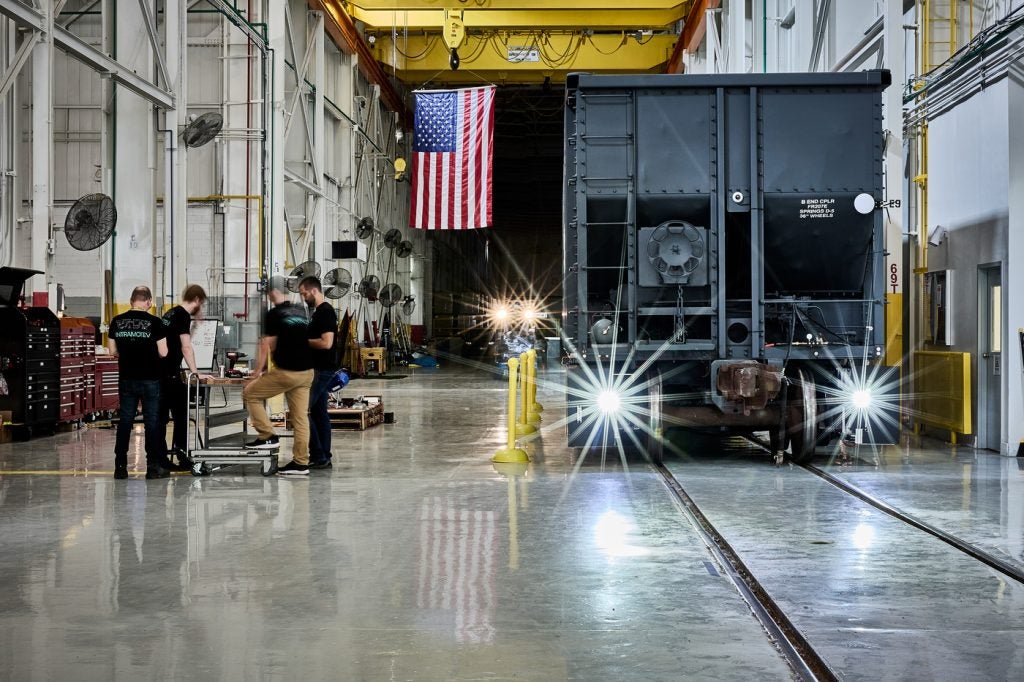
In March 2016, Scotland’s transport minister Derek Mackay launched the government’s new rail freight strategy, an ambitious sector-wide programme called ‘Delivering the Goods’.
It puts forward the vision to develop a state-of-the-art, efficient and competitive rail freight system ready to meet the demands of modern markets and feed into Scotland’s larger plan for sustainable economic growth.
The Scottish rail freight industry has been facing some serious challenges lately. The country’s previously dominant steel and coal markets have seen a “much quicker and more severe” decline than predicted, leaving rail freight exposed and needing to diversify.
“This decline in core commodities has not been matched by market growth in other areas, such as intermodal traffic,” the strategy report reads.
The document also estimated that after Scotland’s last coal-fired power station Longannet was decommissioned in March this year, the rail freight market was left facing “a significant gap” in the region of 50-70%, with insufficient goods needing to be delivered.
Adapting to these dramatic changes is crucial. According to a report commissioned by the Scottish Government and the Rail Delivery Group, rail contributes up to £670m in annual Gross Value Added to Scotland’s economy. It also supports 13,000 jobs and creates a wider economic benefit of £650m. The freight sector represents “a key component of these figures”.
How well do you really know your competitors?
Access the most comprehensive Company Profiles on the market, powered by GlobalData. Save hours of research. Gain competitive edge.

Thank you!
Your download email will arrive shortly
Not ready to buy yet? Download a free sample
We are confident about the unique quality of our Company Profiles. However, we want you to make the most beneficial decision for your business, so we offer a free sample that you can download by submitting the below form
By GlobalDataSo what are some of the critical hurdles the industry is battling and how will the government set out to bring this strategy to life?
Scotland’s rail freight sector faces deep challenges
The new freight strategy shares most of its vision with Scotland’s overarching National Transport Strategy, which is based on developing three core outcomes: improving journey times and connections; reducing emissions; and improving quality and accessibility for all.
However, the freight plan carries two important distinctions. Firstly, it seeks to address the urgent challenge of the coal and steel industries’ decline by branching out to new markets and increasing overseas exports.
According to the document, Network Rail’s 2013 freight market study predicted considerable growth by 2043.
“However, [its] study could not have envisaged the severity and rapidity of the decline of the dominant markets,” the report explains.
Following a three-month consultation which brought together government representatives, private companies, individuals and public bodies, the conclusion was that “there is no single, large market waiting to fill the gap left by coal.”
Furthermore, the sector is also battling with a lengthy regulatory and planning process, which often hinders many businesses from considering moving their goods by rail. This opaque regulation also “undermines rail’s ability to respond to fluid freight markets” due to the fact that it takes a long time to move an idea from testing to delivery, causing missed commercial opportunities.
“This strategy follows a comprehensive consultation process that sought the views of the rail freight industry, businesses, trade unions and other stakeholders,” Mackay said at the launch of the strategy.
“What became clear during this process is that there are growing challenges facing the industry. However, it also revealed a definite desire to tackle them and a need to work together in order to put rail freight back onto a sustainable footing.”
Rail Freight Group (RFG) Scottish representative David Spaven agreed that “the industry is ready to rise to the challenge” and added that “the more freight we can move by rail, the greater the economic and environmental benefit for Scotland.”
Bringing the strategy to life
In order to address the challenges, the strategy focuses on four action plans: innovation, facilitation, promotion and investment.
When it comes to innovation, the document recognises that “the Scottish rail industry is in a period of change”. On its part, the government assumes its role as the main funder of railways, and urges the rail freight industry to provide advice on the creation of an “innovation fund” by autumn 2016.
Furthermore, the Scotland Freight Joint Board was tasked with looking at the barriers to innovation and attracting new freight, network capabilities, and export potential, as well as identifying new markets for pilot initiatives. The board will also commission a study on the potential for an ‘urban freight network’, exploring the use of parts of the network to move goods to city centres.
Another essential part of the action plan is the recognition that no single department can create the necessary advances alone. Although the government admits that there is no need to change the partnership structures already in place, it sets out to work with the Office of Rail and Road, the ScotRail Alliance, Network Rail’s national freight team and the wider industry to explore new avenues, such as sharing freight movements.
Through better nationwide promotion, the strategy will also try to address a lack of awareness amongst business owners regarding the benefits of using rail freight, who often resort to road transportation due to this lack of information.
By October 2016, the Scotland Freight Joint Board is to produce a simple guide to increase awareness of rail freight and its benefits. The guide will highlight statistics such as 96% of trains running on time, £241m in travel time savings through reduced road congestion, and the prevention of 57 yearly road casualties and fatalities. This will also be supported by an informative website and a series of rail freight conferences across Scotland.
Regarding investment, Scotland has a good track record, with over £6bn invested in infrastructure and services since 2007. In addition, a further £5bn is earmarked for the industry until 2019, including a targeted Scottish Strategic Rail Freight Investment Fund of £30m.
However, certain areas for improvement were identified, particularly when it comes to coordinating cross-border services between Scotland, England and Wales.
“It is of critical importance that the Scottish and UK Governments take a joint approach to investment in rail freight as it affects cross-border flows,” the document specifies.
As part of this plan, the board will put out a market commodity study, which will include rail industry advice for investment post-2019. Furthermore, a focus group established by the Scottish and UK Governments will ensure that there is a “complete alignment in the investment strategy for rail freight” between the two.
Measuring success and looking to the future
The strategy document concludes that at this stage, “hard targets should not be set for the rail industry”.
However, the programme will be tracked and its progress will be measured against factors such as sustainability, performance, resilience, formed partnerships and return on investment.
An initial report detailing the progress will be published by the government by June 2018, two years after the implementation of the strategy.
“The reality is that we need to work together to place our rail freight industry onto a sustainable footing,” Mackay said.
“By offering a range of concrete actions that will lead to increased innovation and collaboration across the industry, targeted investment in Scotland’s strategic freight network and better promotion of the benefits of rail freight both to business and society, we can create the conditions that will allow the sector to prosper and grow.
“I am confident that this strategy will lay the necessary groundwork for creating a sustainable, high quality, highly efficient rail freight industry that Scotland needs, wants and deserves,” he concluded.







